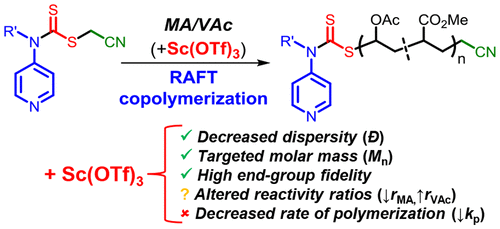当前位置:
X-MOL 学术
›
Macromolecules
›
论文详情
Our official English website, www.x-mol.net, welcomes your
feedback! (Note: you will need to create a separate account there.)
Effect of Scandium Triflate on the RAFT Copolymerization of Methyl Acrylate and Vinyl Acetate Controlled by an Acid/Base “Switchable” Chain Transfer Agent
Macromolecules ( IF 5.1 ) Pub Date : 2018-01-05 00:00:00 , DOI: 10.1021/acs.macromol.7b02104 Ashton Tselepy 1 , Tara L. Schiller 2 , Simon Harrisson 3 , Carlos Guerrero-Sanchez 4, 5 , Graeme Moad 4 , Daniel J. Keddie 1, 4, 6
Macromolecules ( IF 5.1 ) Pub Date : 2018-01-05 00:00:00 , DOI: 10.1021/acs.macromol.7b02104 Ashton Tselepy 1 , Tara L. Schiller 2 , Simon Harrisson 3 , Carlos Guerrero-Sanchez 4, 5 , Graeme Moad 4 , Daniel J. Keddie 1, 4, 6
Affiliation

|
Modulation of the activity of an acid/base switchable dithiocarbamate RAFT agent, cyanomethyl (4-fluorophenyl)(pyridin-4-yl)carbamodithioate, with the Lewis acid scandium triflate (Sc(OTf)3) was investigated to examine the ability to deliver improved control over RAFT copolymerizations involving both more-activated and less-activated monomers—specifically the copolymerization of methyl acrylate (MA) and vinyl acetate (VAc). The introduction of either 0.5 or 1 mol equiv of Sc(OTf)3, with respect to RAFT agent, into a RAFT copolymerization of MA and VAc provides substantially improved control resulting in significantly reduced molar mass dispersities (Đ) (∼1.1–1.3) than achieved in its absence (Đ ∼ 1.3–1.4). Furthermore, similar introduction of Sc(OTf)3 into MA homopolymerization mediated by the same RAFT agent also delivered polymers of very low Đ (∼1.15). Sc(OTf)3 was also found to lower the rate of polymerization and alter the copolymerization reactivity ratios for MA and VAc. Increasing the Lewis acid concentration provides enhanced incorporation of the less active monomer, VAc, into the copolymers ([Sc(OTf)3]/[RAFT] = 0, rMA = 4.04, rVAc = 0.032; [Sc(OTf)3]/[RAFT] = 0.5, rMA = 3.08, rVAc = 0.17; [Sc(OTf)3]/[RAFT] = 1, rMA = 2.68, rVAc = 0.62). Carbon nuclear magnetic resonance (13C NMR) and differential scanning calorimetry (DSC) analysis of preparative samples confirm the enhanced VAc incorporation with increased levels of Sc(OTf)3. Importantly the inclusion of Sc(OTf)3 does not deleteriously affect the thiocarbonylthio end-groups of the RAFT polymers, with high end-group fidelity being observed in all copolymerizations.
中文翻译:

三氟甲磺酸on对酸/碱“可转换”链转移剂控制的丙烯酸甲酯和乙酸乙烯酯的RAFT共聚的影响
研究了路易斯酸三氟甲磺酸((Sc(OTf)3)对酸/碱可转换的二硫代氨基甲酸酯RAFT试剂氰基甲基(4-氟苯基)(吡啶-4-基)氨基甲二硫酸酯的活性的调节,以研究其递送能力改进了RAFT共聚反应的控制,涉及更多活化的单体和活化程度较低的单体,特别是丙烯酸甲酯(MA)和乙酸乙烯酯(VAc)的共聚。相对于RAFT剂,将0.5或1摩尔当量的Sc(OTf)3引入MA和VAc的RAFT共聚中,可显着改善控制效果,从而显着降低摩尔质量分散度(Đ)(〜1.1-1.3)比没有它的情况下所达到的(Đ〜1.3–1.4)。此外,类似的引入钪(OTF)的3到MA均聚用相同的RAFT剂介导的递送也非常低的聚合物Đ(~1.15)。还发现Sc(OTf)3降低了聚合速率并改变了MA和VAc的共聚反应率。路易斯酸浓度的增加可提高活性较低的单体VAc掺入共聚物中的含量([Sc(OTf)3 ] / [RAFT] = 0,r MA = 4.04,r VAc = 0.032; [Sc(OTf)3 ] / [RAFT] = 0.5,r MA = 3.08,r VAc = 0.17; [Sc(OTf)3] / [RAFT] = 1,r MA = 2.68,r VAc = 0.62)。制备样品的碳核磁共振波谱(13 C NMR)和差示扫描量热法(DSC)分析证实,随着Sc(OTf)3含量的增加,VAc的掺入增加。重要的是,包含Sc(OTf)3不会有害地影响RAFT聚合物的硫代羰基硫基端基,在所有共聚中均观察到高端基保真度。
更新日期:2018-01-05
中文翻译:

三氟甲磺酸on对酸/碱“可转换”链转移剂控制的丙烯酸甲酯和乙酸乙烯酯的RAFT共聚的影响
研究了路易斯酸三氟甲磺酸((Sc(OTf)3)对酸/碱可转换的二硫代氨基甲酸酯RAFT试剂氰基甲基(4-氟苯基)(吡啶-4-基)氨基甲二硫酸酯的活性的调节,以研究其递送能力改进了RAFT共聚反应的控制,涉及更多活化的单体和活化程度较低的单体,特别是丙烯酸甲酯(MA)和乙酸乙烯酯(VAc)的共聚。相对于RAFT剂,将0.5或1摩尔当量的Sc(OTf)3引入MA和VAc的RAFT共聚中,可显着改善控制效果,从而显着降低摩尔质量分散度(Đ)(〜1.1-1.3)比没有它的情况下所达到的(Đ〜1.3–1.4)。此外,类似的引入钪(OTF)的3到MA均聚用相同的RAFT剂介导的递送也非常低的聚合物Đ(~1.15)。还发现Sc(OTf)3降低了聚合速率并改变了MA和VAc的共聚反应率。路易斯酸浓度的增加可提高活性较低的单体VAc掺入共聚物中的含量([Sc(OTf)3 ] / [RAFT] = 0,r MA = 4.04,r VAc = 0.032; [Sc(OTf)3 ] / [RAFT] = 0.5,r MA = 3.08,r VAc = 0.17; [Sc(OTf)3] / [RAFT] = 1,r MA = 2.68,r VAc = 0.62)。制备样品的碳核磁共振波谱(13 C NMR)和差示扫描量热法(DSC)分析证实,随着Sc(OTf)3含量的增加,VAc的掺入增加。重要的是,包含Sc(OTf)3不会有害地影响RAFT聚合物的硫代羰基硫基端基,在所有共聚中均观察到高端基保真度。











































 京公网安备 11010802027423号
京公网安备 11010802027423号